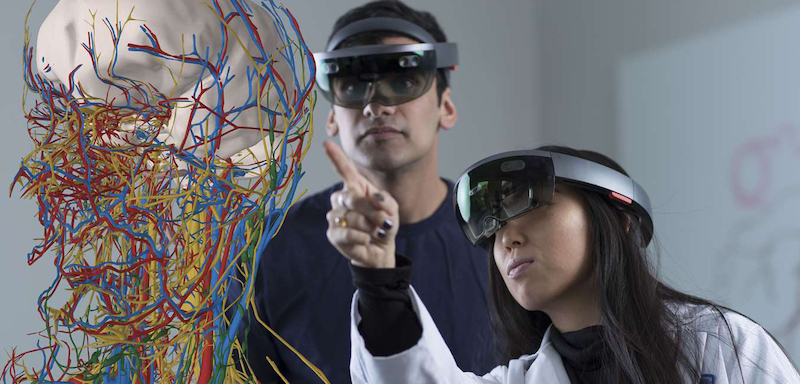STEM is dominating education discussions and there is good reason for that. Most of today’s most popular college majors and, subsequently, the highest paying and most reliable jobs are those that fall under the STEM fields. Since this is true, you might think that every student entering college is going to pursue a STEM degree in one way or another, but there are plenty who still choose to follow a different passion. Mastering a STEM-related craft and earning that degree, however, is one of the best ways to ensure future success, but what are the best college majors for those who want a lifetime of STEM challenges? Is it engineering or computer science? Or, might there be some other options to consider. We’ll take a look at some of the best options and how students can make their futures happen!
Computer Science Climbing Among STEM Majors
As future college students take the time before graduating high school to decide on a major or area of focus for the next four years, more and more of them are deciding to take on STEM majors. Among the most popular STEM majors is computer science because it is used in so many of today’s most prestigious jobs. Also known as coding, computer science holds the key to so many of the jobs that need to be completed in today’s economy and coding is an essential skill for anybody who wants to work in this arena. Back in 2013, computer science was the eighth-most popular STEM major, according to a report from the ACT. By 2016, it had grown to the fourth-most popular. The only STEM majors that remain above it are biology, mechanical engineering, and biochemistry. In just the last five years, computer science has passed traditionally popular STEM majors, like chemistry, engineering, and marine biology as it continues increasing in popularity and necessity dictated by the state of the economy.
The survey that placed computer science as the fourth-most popular STEM major utilized student interest and aptitude to rank the majors. Compared to the growing rate of other STEM majors on the list, computer science is the fastest growing, increasing in popularity at 2-3 times the rate of most others. This does have a lot to do with the fact that a background in computer science makes a college graduate extremely attractive to employers from a number of different industries. It is also an indication that students are genuinely enjoying majoring in computer science—at least a lot of the time. The number of students who express an interest in pursuing computer science while still in high school is also on the rise. If nothing else, this supports the belief that computer science is genuinely popular and also indicates that, even at a young age, students are cognizant of the fact that it could provide them with all kinds of future opportunities.
The amount of STEM majors who end up graduating with a computer science degree is also growing, though that number is not currently huge. Along with it, the number of high school students who go on to pursue computer science in college is growing, which should hopefully lead to the number of graduates increasing over time. There is also every reason to believe that more students are going to be leaving high school with the intent of majoring in computer science. Every year, the number of kids participating in the Hour of Code grows, seeming to indicate that both kids and their teachers are fully aware of the importance and potential of computer science skills. As they enter their college years, opportunities to develop and perfect these skills are crucial, but certainly attainable. As computer science evolves and gains more popularity, students who take part in it will find themselves in a pretty favorable position a little ways down the road.
STEM Starting to Dominate Most Relevant Majors
The number of high school guidance counselors who spend time every day trying to persuade students to pursue STEM is probably quite high. Technology has a pretty strong hold on our lives and has led to the creation of an entirely new economy—one that revolves around STEM and rewards those who are able to excel at it. For that reason (and some others), STEM majors are really beginning to dominate the top spots among students entering college whether it be by popularity or necessity. Whatever it is that they are passionate about, there’s a good chance that, if it is something STEM-related, students can profit from it for a long time. It’s no secret that some college degrees are more valuable (and more profitable) than others and, year after year, it seems as though the STEM degrees fall into the side of the aisle that’s more profitable. And, not just one particular STEM degree—it’s more like almost all of them.
Just how popular are STEM majors among today’s crop of college students? Well, there are not as many entering college looking for a liberal arts or communications degree as there used to be even just 10 or 15 years ago. STEM is really starting to dominate the top-15 most popular majors, according to a report from Bankrate. Of the 15 most popular college majors at the time the report was released, 14 of the top-15 were STEM-related with only No. 14 (public policy) falling outside of the STEM fields. Not only do STEM fields tend to have the best pay, which is certainly attractive to recent graduates, they also routinely have among the lowest unemployment rates. If you have the STEM skills, you’re pretty much guaranteed to have a job because employers are actually struggling to find qualified candidates to fill a lot of the positions left open by the current direction of the workforce and its reliance on STEM professionals.
So, what are the top areas to major in, according to this report? At the top of the list is actuarial science, followed by Zoology, nuclear engineering, health and medical preparatory programs, and applied mathematics. Sounds like a whole lot of STEM in that group. Of the bottom-five majors mentioned in the report, the list includes visual and performing arts, cosmetology and culinary arts, clinical psychology, composition and speech, and miscellaneous fine arts. Not as much STEM in that group. It’s not to say that a graduate in today’s climate would not be able to make a respectable living outside of STEM, but the numbers certainly give every indication that STEM is the way to go—both in terms of salary potential and less of an unemployment risk. Plus, there are still plenty of areas students can focus on that fall within the STEM scope if the careers mentioned on the list aren’t something they really love!

A Guide to STEM Majors
Not only do STEM degrees carry with them the near certain promise of a fulfilling career, there are so many of them for students to choose from. As long as they have the skills and earn their diploma, so many of today’s most exciting and rewarding careers are waiting for graduates from the STEM fields. Science, technology, engineering, and math careers offer college graduates tons of prospects for a flourishing future. It’s true that they are generally better paying than jobs in other fields, but growth in these industries is also compelling students to put in the work. Now, more so than in years past, there is a growing list of STEM jobs graduates could potentially fill as technology keeps expanding and the need for skilled workers grows with it. And, this has led to STEM disciplines now being covered in many different educational departments at colleges and universities, so students are getting more exposure to STEM as they learn.
Some of the most popular STEM majors are computer science, information technology, physics, engineering, chemistry, astronomy, health sciences, biology, mathematics, and earth sciences. Within each of these general disciplines, there are now hundreds of emerging subdivisions within which students can specialize. Engineering, for example, is no longer simply learning how to build buildings and bridges. Some of the subcategories an engineering major could find themselves in include aeronautics, chemistry, and electronics. This is just one example of how STEM majors have changed a whole lot over just the last 20 years or so. The large variety of options coupled with the way professors are able to use technology to enhance instruction and practical experiences is also opening up an increasing amount of opportunities for STEM students. Since STEM is stretched so far now, students aren’t limited to one particular thing and can stretch their interests and aptitudes across multiple different areas, making themselves more versatile and valuable in the process.
As time’s rolled on, studying a STEM major has actually evolved into much more of a team sport than an individual endeavor. STEM students are routinely working with others—some of whom might even be in a different school. Some who are following the situation closely have noted that the walls between STEM disciplines have come down for STEM majors, which has opened up many more opportunities for collaboration, mirroring more of what it’s like in the real world. Any student who possesses strong analytical and problem-solving skills is a good candidate to pursue a STEM degree. It is also important, of course, that students maintain good grades in high school and take part in leadership opportunities. Finally, despite all of the STEM majors now available to college-bound students, it’s still ideal to explore all options before settling on something prematurely, a process that tends to help kids discover what it is they’re truly passionate about.
VR Becoming a Serious Consideration for STEM Majors
We say it all the time that the trends in education are influenced by the economy. Well, in the past couple of years, educators have been turning to virtual reality to supplement their instruction and engage their students more deeply. At first, VR was simply thought of as a medium that can be used to bolster student engagement in the classroom by offering them a whole new way to learn. Now, however, as virtual reality is being used more and more frequently in the workforce, some schools are creating virtual reality majors and programs so that students can learn all about it while they’re in college. Don’t get us wrong—this sounds incredibly exciting, but, for something that’s still very young, it’s certainly alright to be skeptical. As VR continues to invade our world, is it possible that this is just the beginning and more and more colleges will go as far as making VR a major option? We’ll have to wait and see, but, for now, it certainly seems like a possibility.
One of the colleges that is among the first to offer a VR major is Shenandoah University in Virginia. The goal of the program is to allow enrolled students to learn more about the human experience behind the technology and train the next generation of students for an increasingly diverse set of careers. Of the careers today’s college students could find themselves in, it seems at least partially likely that many of them will center around some of today’s emerging technologies, like artificial intelligence or virtual reality. What’s also cool about this major is that it will primarily be student-run and contain three different concentration areas students can major in. They are theater, filmmaking, and computer science, all of which have promising potential for legitimate careers in VR. Students in this program work with industry experts, who guide their projects and illustrate the real-world applications of virtual reality.
In the VR program at Shenandoah, students who take part will be participating in a more humanistic approach to understanding VR rather than the coding or the software creation. Virtual reality has been used to help treat patients with various impairments, including anxiety and PTSD among others. One of the things these students will learn is how to create virtual experiences that provide better outcomes for the people who can be helped with this technology. Though it was the industry demand for VR that drove the creation of this particular program, the school is now also exploring additional avenues for how students can apply what they learn in a future career. Just to give one more example from Shenandoah, they worked with students who have learning challenges and put them in a virtual environment to simulate a job interview. This helped these young adults develop improved interpersonal skills and really aided in their preparation for a future job interview—just one of the innovative ways virtual reality can be used in the everyday world and why we might see more VR programs spring up in colleges very soon.

Succeeding in the Most Lucrative STEM Professions
Earlier in the post, we touched on the top-5 most lucrative STEM majors in the country. In case you forgot, they are actuarial science, zoology, nuclear engineering, medical studies, and applied mathematics. Before we wrap up this week’s post, we’re going to discuss some of the skills employers in these areas are looking for, how students can develop them, and what might be expected of them if they accept one of these roles in the future. We say it all the time, but it bears repeating that people who hold these jobs will need a mix of both hard and soft skills. Much of the economy is powered by STEM fields, so it’s natural to conclude that a STEM degree will lead to greater employment and a greater return on the investment of college. Aside from the financial benefits, we’re going to take a look at what graduates who earn degrees in these top STEM fields will need to know and what they will likely be asked to do.
A student majoring in applied mathematics, for example, is going to be spending a lot of time learning how to apply the principles of theories to the real world. That sounds similar to a lot of the STEM learning that goes on in K-12 classrooms as applying knowledge to the current states of the world is a very important thing to be able to do. For medical majors, on the other hand, they need to know a lot about science, including, of course, biology, chemistry, physics, and math. They obviously must be experts on the human body and how outside factors can affect it. Those are the hard skills, but they also need to master the soft skills, like communication and outside-the-box thinking, so that they are able to act swiftly and communicate with patients effectively when called upon to do so. For nuclear engineers, they’ll learn all about nuclear reactions, radiation, nuclear materials, and more in order to learn how to eventually design equipment and operate within federal laws.
The No. 2 major is zoology, which also requires students to know a ton about the biology of animals. They also spend a lot of time studying the environment, however, which could come in handy in a lot of different STEM fields if making a career change. Finally, when studying actuarial science, students are focusing on learning about statistics, math, and assessing and understanding risk. Many of the jobs these graduates take are in the insurance and financial fields, which make sense because we're all concerned about well-being and money. Using the skills they learn, actuarial science majors are able to weigh risk, understand uncertainty, and minimize both of those. So, that's our look at some of the top STEM majors and what it might take to excel at them. And, perhaps there will be five different majors on the list in a few years!
For the latest EdTech, STEM, and 21st century education news, follow us on Twitter and Instagram. Like us on Facebook, too, or sign up for our newsletter for our latest product announcements and offerings. If you have an idea for an Eduporium Weekly theme, send us a message on social media or comment below.



